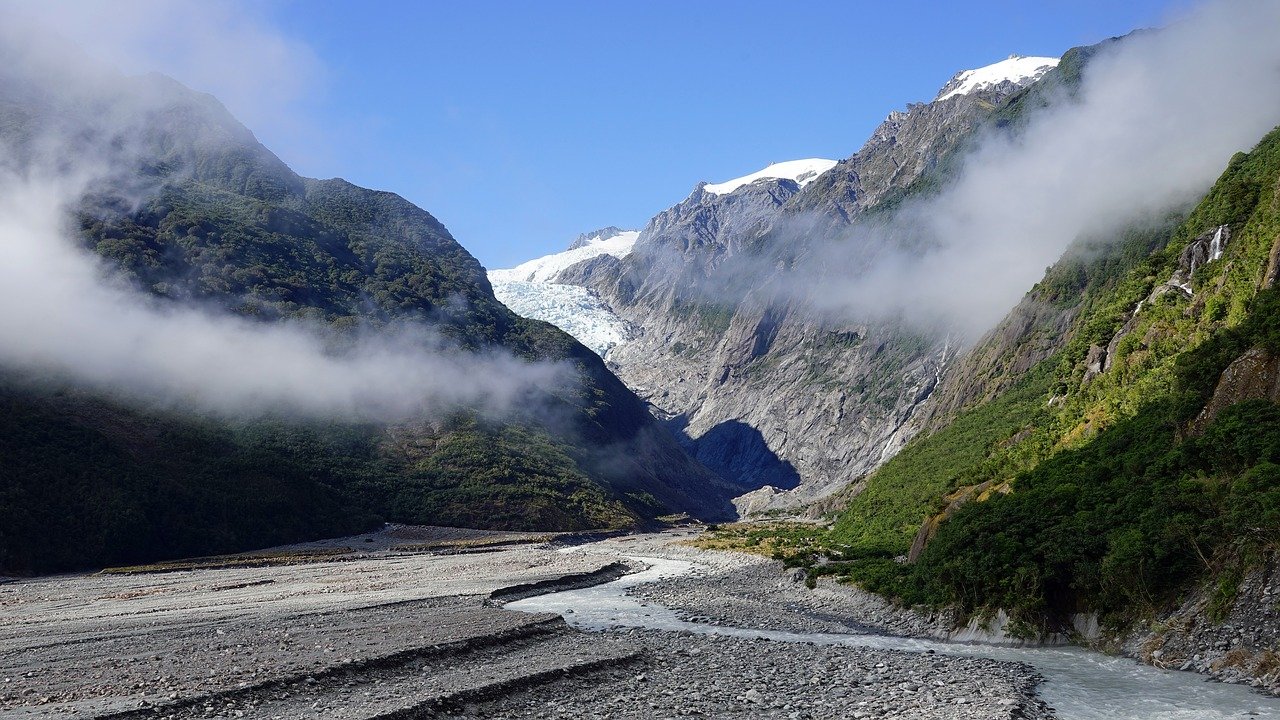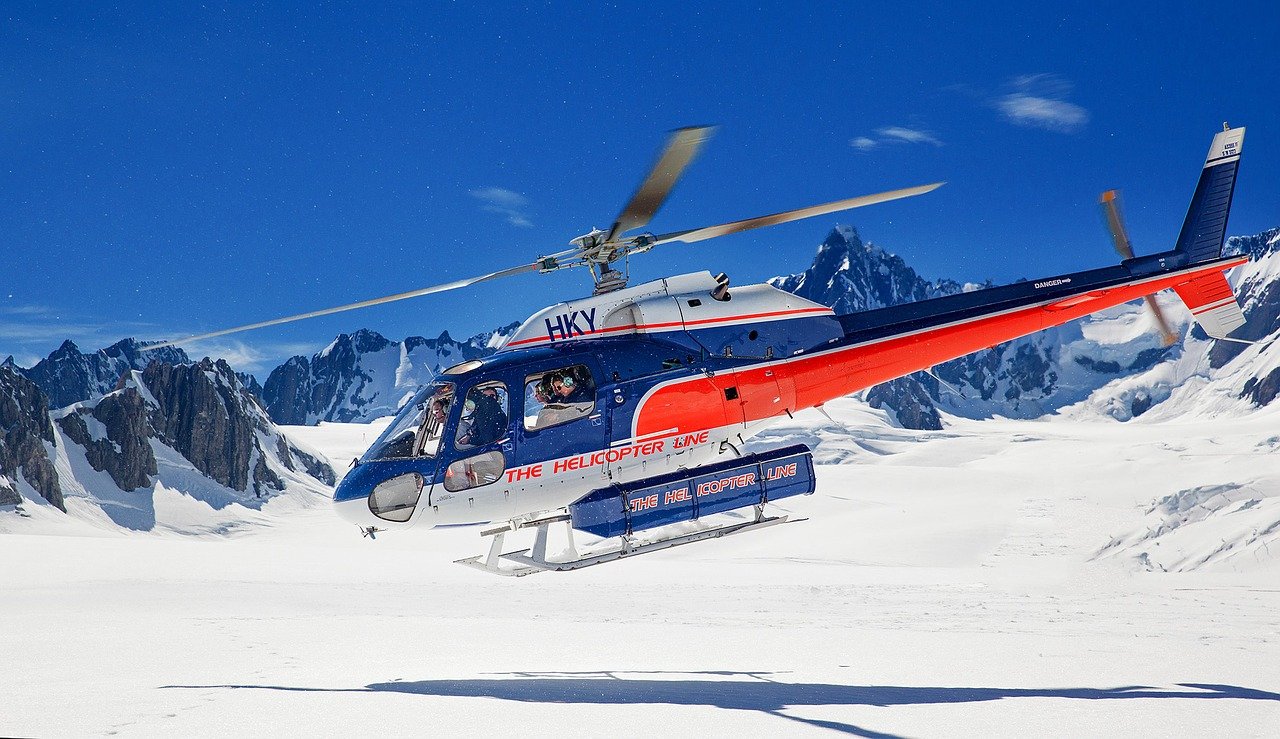
Retreating ice endangers their safety … and their livelihoods.
New Zealand’s Southern Alps are crowned by some of the most accessible glaciers on Earth. Despite the country’s temperate latitude, large glaciers like the Fox and Franz Josef sweep down from the mountains to the coastal rainforest below. However, climate change may be altering that. Low-elevation glaciers like the Fox and Franz are retreating quickly across New Zealand. This is bad news for glacier guides like Macomb Richards.
Richards has spent the past 15 years helping tourists from around the world experience the Fox Glacier, one of New Zealand’s largest and fastest-retreating glaciers. Throughout his career he has personally witnessed the surprising speed at which these glaciers are disappearing.
Researchers like Heather Prudi and her colleagues at New Zealand’s University of Canterbury have determined that the Fox and Franz Josef Glaciers are smaller and retreating more rapidly now than at any other time in their history. This is having profound effects on Richards’ livelihood. However Richards and his fellow guides will have to contend with more than just a loss of ice as their country’s glaciers dwindle.
Relying on rockfalls and helicopters for access
Richards says the glacial retreat has made his job much more dangerous, adding more elements of risk to every journey for his clients and for him. As glaciers retreat, they often get thinner and lower in height as they lose ice mass. For Richards and fellow guides, the major concern is for safety. He explained in an email that “As the glacier is lowering in height and pulling back from the valley walls, there is less support at the base of the mountain sides. This means we are seeing more rockfalls and bigger events.”
“Some areas that have been traditionally stable, have now become active,” he continues. “The lower height of the ice has also meant we don’t have the natural catching features on the glacial margins, so rocks are making it further out onto the glacier.” To keep guides and clients out of ever-increasing rock fall zones, Richards has to constantly reduce the size of his guiding territory. Not only is Richards losing ice to climate change, increased rockfall risks make the ice that remains more dangerous for clients and guides alike.
However, the biggest change to Richards’ guiding operations came in 2014. After several years of rapid retreat by the glaciers, he felt he could no longer safely lead clients from the valley onto the glaciers. This practice had been done by guiding operations without climate-related interruption for well over 100 years until 2014. Now he relies on helicopters to deliver clients to the ice above. “Being helicopter-dependent increases cost, adds layers of risk, and makes [the trips] more weather dependent,” Richards says. In addition, the changes make running a guiding company more expensive, less productive, and more logistically challenging.
Prudi, the researcher, said in an email that the situation is unlikely to improve. Her research shows the Fox Glacier has already retreated by about 880 meters – more than half a mile – since 2009 when the most recent retreat phase began. Glaciers like Fox respond rapidly to small climate perturbations and undergo short-lived advance and retreat cycles. Prudi says her research indicates the Fox and Franz Josef glaciers will be reduced to just their high-elevation accumulation zones at some point in the near future. However, she said that the short-term variability of these glaciers makes it difficult to pinpoint exact timelines.
This situation is bad news for Richards, who guides clients only on the more narrow lower elevation sections. The upper-accumulation zones presently are routinely covered in deep snow, making it impossible for him to run the same types of trips that guides have been leading on these glaciers for over a century. Given the rapid rate of retreat, Prudi said, “we need to be thinking very carefully about our current approach to ‘chasing the glaciers up the mountain’ with helicopters.”

Pictured: A helicopter at New Zealand’s Fox Glacier. Image by Julius Silver.
Shrinking territories for guides and their clients
New Zealand glaciers are retreating at different rates. According to Prudi’s research, the nearby Franz Josef glacier is much thinner and shallower than the Fox despite their being of equal size. As a result, Franz Josef could retreat much faster than the Fox Glacier. She said it is possible that the part of Franz Josef where guides currently take clients could be completely gone in as little as 30 years. Guides would inevitably have to look elsewhere to take their business.
As conditions change and guiding companies lose their traditional territories to rockfalls and a lack of adequate ice, Richards says he is worried that guiding companies may battle over the declining amounts of remaining guidable space. “We are not the only company having these problems,” he noted, “so long term, different companies might be squeezed out of their traditional operating areas. This could lead to more friction between operators.”
The retreat of these glaciers is an existential threat to many people on the West Coast of New Zealand’s South Island. Glaciers are big business in an area with little other industry. After a short-lived gold rush in the early 1900s, many newly settled New Zealanders turned toward tourism to supplement their incomes. The towns of Franz Josef and Fox, named after the nearby glaciers, were founded with tourism as their economic bedrock, and each relies on glacier tourism. For a preview of the worst-case scenario, one need only walk the nearly empty streets of either town during the Covid-19 pandemic, when travel restrictions kept away the vast majority of tourists.
Preparing for a southern New Zealand future without glaciers
Richards and other local businesses are left grappling with running a glacier-oriented business in a warming world. Hotels, bars, restaurants, and other tourist companies all face similar major challenges in the near future. Without the glaciers, not many tourists are likely to come to these towns.
Research from Prudi and others at the University of Canterbury show that decades-long advance and retreat cycles make it hard to predict the future of New Zealand’s glaciers. However, at some point, researchers fear a time when New Zealand’s glaciers disappear from all but the highest summits, if not completely. Then, New Zealand glacier guiding will be history.
Richards is already preparing for that future. “As a company, we are having to explore other trips and experiences that don’t involve getting onto the glacier.”
Richards and his neighbors in Westland understand that climate change is occurring now, and that the retreating glaciers pose a real threat to their way of life. For other communities, the threat of climate change may look like poor crop yields, drought, sea-level rise, wildfire, or extreme weather events.
It is easy to focus on each local event as a distinct issue, but all the local issues are connected. It may already be too late to save the glacier guides of New Zealand, but by fighting climate change now with bold action, many experts say they remain hopeful that the world may stave off the worst-case impacts.
This article is republished from Yale Climate Connections under a Creative Commons license.
Cover image: New Zealand’s Franz Josef Glacier, captured by Bernd Hildebrandt.

